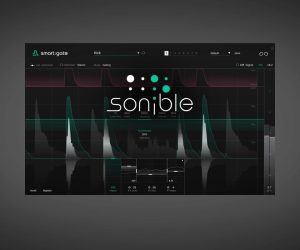
Review: Smart Research Smart Guitar DI System Deluxe
When the KAOS of long distance cable runs, multi-amp setups and ground loops are cramping your guitar genius, the only real option is to Get Smart.
In a digital age where many of us have sadly come to accept that sessions will be interrupted by DAW instability or the latest driver and hardware conflict, it’s easy to forget there are professionals out there striving to make useful tools that simply work.
Al Smart of Smart Research is just such a professional. Acclaimed for his C1 and C2 compressors, Al spent many years travelling the world commissioning SSL consoles, taming the gremlins of each installation and devising his own solutions to some age-old recording pitfalls along the way [See AT issue 34 for our interview with Al Smart]. Conceived during the construction of Peter Gabriel’s Real World Studios, perfected during Al’s first stint as a resident of St Kilda and finally tested in Melbourne’s Metropolis Studio 2 (before it closed), the Smart Research Smart Guitar DI system has successfully made the transition to the production line – but just how smart is it?
NOW LISTEN CAREFULLY…
On first inspection, the industrial minimalism of the two Smart boxes that comprise the Smart Guitar DI System Deluxe does little to inspire. Indeed, one wonders whether the use of the words ‘System’ and ‘Deluxe’ may be gilding the lily just a smidge. Be warned however, these are not your ordinary guitar DIs. In Al Smart’s own words, they’re a “set of instrument level, unity gain building blocks.” What you can achieve with them is limited only by your audio IQ.
In practical terms, these “building blocks” provide five instrument DI inputs (one active, four passive), four transformer-isolated balanced outputs, four transformer-isolated unbalanced outputs, a speaker level input and a line driver, to connect the two units together and allow guitar amplifiers to be driven via cable runs of up to 300 metres, without degradation. That’s pretty smart…
READY TO TRANSMIT
To all intents and purposes the two Smart Guitar DI boxes look almost identical. They’re so similar in fact that they’re easily confused in a late-night session haze. The Transmit box features an active high-impedance guitar input, which feeds a low-distortion buffer amp powered by either an internal 9V battery or the provided external DC plug-pack (9–24V). This input also makes use of ‘soft-switching’ to minimise the problems associated with that nasty unplugging thump.
The output of the buffer amp (unity gain) connects to a line driver and a series of balanced and unbalanced outputs. The line driver, or Transmit output, will drive any load down to 80Ω via a male XLR socket, including headphones. In most cases this will be used to drive the Receive input of the other box via a microphone lead or your studio multicore. From here the signal is internally routed to the DI Box/Splitter section, which is itself split into two channels. Each channel providing a transformer-isolated, unity gain balanced output (to Line) and transformer isolated, unity gain unbalanced output (to Amp). All four of these are capable of driving loads from unbalanced guitar amps right down to 600Ω guitar effects or line inputs. Both channels also feature a three-position ground isolation toggle selector to connect the earth to either pin-1 of the Line output or to the Amp; or to disconnect the earth entirely from both outputs.
It’s here though that the Smart Guitar DI adds a clever twist to the formula. The DI Box/Splitter section also offers a passive transformer-based DI input on each channel, using ‘break jack’ connectors to bypass the Active input. When used in this way, the Smart Guitar DI System Deluxe becomes two passive stereo DI boxes with an input impedance of 2.4KΩ for use with keyboards or other electronic instruments. These inputs will even accept balanced TRS jacks for other routing solutions you might need.
RECEIVING YOU LOUD AND CLEAR
The Receive box of the Smart System also features a passive two-channel DI Box/Splitter section. Where it differs, however, is in its inputs. The Receive box is completely passive, requiring no internal or external power source. Instead, the unit can be driven either by the Transmit box via female XLR input or via a Speaker Simulator 1/4-inch mono jack input.
One of the first of its kind when developed, Smart’s Speaker Simulator allows for the direct recording of ‘dirty’ DI signals straight from an amp’s speaker output, without the need for a speaker to be attached. The signal is passed through a series of pads and filters to both protect the amplifier and route it to the DI output channels. Again, this input makes use of a break jack connection to automatically bypass the Receive input. It’s worthwhile noting that when using the Speaker Simulator it’s still possible to make use of this unit as a Receive box. Simply plug a TRS adapter onto the end of your XLR Transmit line and connect it to passive DI input two. With only an extra set of DI transformers in the chain, this is only slightly less ideal and greatly increases the flexibility of the Receive unit.
CONE OF SILENCE
I first became interested in this product primarily due to problems I’d been having in my own recording setup, based in a 100-year-old house. With a warren of rooms and some ‘interesting’ vintage electrical wiring, I had always struggled to offer simple remote guitar amp’ing and DI options, without suffering the frustrating intrusion of hum and ground issues. Several long guitar leads connected via A/B boxes, cheaper DIs and other dubious patching methods would link musicians in the control or live rooms to their remote amplifiers. The results were more often than not, clumsy, untidy and less than satisfactory.
Connecting the Transmit and Receive boxes via my 25 metre multicore, I was up and running in a flash, and there was no need for extra cabling running under doors, threatening to tip over amps and instruments at the slightest trip. The Splitter options on both boxes quickly facilitated independent tuner splits and multiple amp options, and at first listen the results were impressively silent. The DI recordings of both bass and electric guitar were full and detailed, and made a previous purchase of a decent re-amp box feel worthwhile for the first time ever.
Using the Speaker Simulator, I was easily able to capture a great ‘dirty’ DI signal from a modified ’60s stereo tube amp. The passive DI inputs meanwhile worked faultlessly on a stereo recording of a Roland Juno6 and some classic beatbox drum machines. You can even record ‘dirty’ and clean DI signals simultaneously, along with remotely mic’d amplifiers, using a simple speaker line split. Switching the Transmit and Receive boxes over –with the Transmit box now in the recording space – I was easily able to capture bass guitar via an active DI, mic up a remote bass amplifier, and at the same time capture a passive DI recording of the Wurley player as the two musicians jammed together. This smart little system refuses to limit itself to the obvious one-dimensional applications, and as a compact addition to your audio toolbox it’s a real powerhouse.
MISSED IT BY THAT MUCH
The Smart Guitar DI System Deluxe is beautifully designed and outstanding in its utility, so it almost feels petty to nit pick. There are, however, a few shortcomings. First of all the build quality feels a little light. While certainly rugged looking the boxes themselves are actually featherweight and their thin and soft sheet metal cases don’t seem capable of surviving the knocks and falls that the slightest tug on a lead may bring. To this end, I have been assured that we should see a more solid and weighty version of the Smart System in the not too distant future. This would definitely improve its durability I’d wager.
In addition, an expansion of the colour scheme to allow for perhaps a yellow-labelled Transmit box and red-labelled Receive box wouldn’t go astray, as I’ve regularly found myself holding the wrong unit when acting in haste.
Finally there’s the price. While not cheap at $775, it’s the divergence in the international pricing which is most frustrating. There seems to be little relationship between the UK, US and Aussie prices considering current exchange rates. Again I have been assured that the US price will be going up and the local price coming down to correct this imbalance so keep this in mind if you’re considering a purchase. I would also suggest that the optional Re-amp cable ($50), not reviewed here, should be included as a part of the Deluxe system
All in all though, the Smart Guitar DI System, is a total winner. Its functionality and sonic quality make patching around rooms in home studio a breeze. It eliminates hums and buzzes like Mortein and cures home recordists of the disquiet they feel when nervously plugging in and hoping for the best.
















RESPONSES